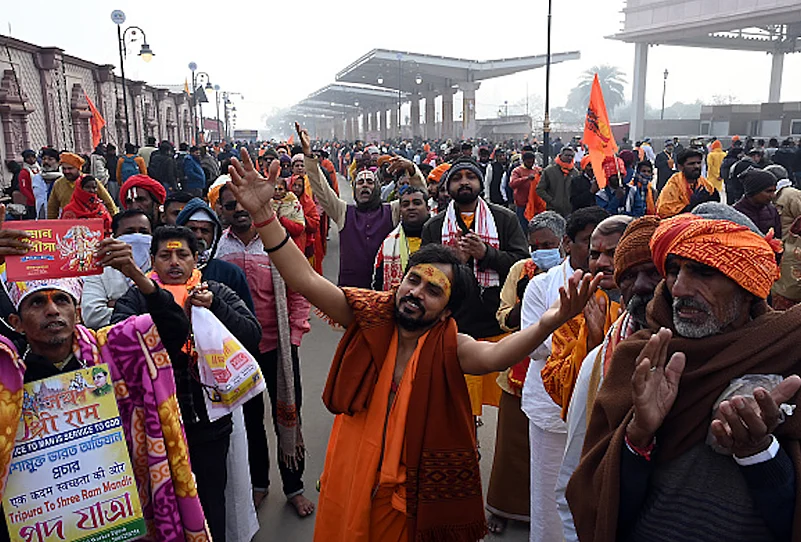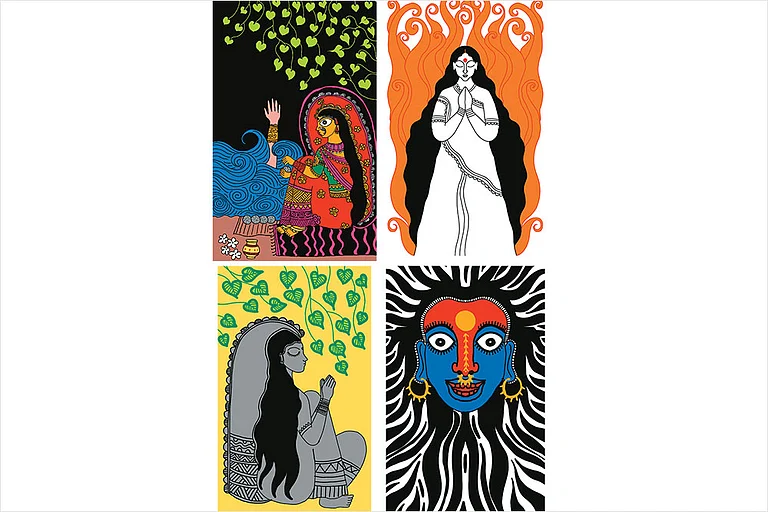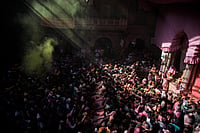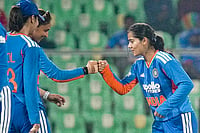Of late, the Ramanandi sect of Ram devotees has been in news in the context of the inauguration of the Ram temple in Ayodhya. While a lot has been said about this sect, we ought to keep in mind that this important bhakti sect is not a monolith. Far from it, it boasts of several internal subdivisions, of which the Rasikas are the most interesting. The male Rasika devotees dress up as women and worship their deity, lord Ram. They fashion themselves as maids (Sakhis) of Sita or as the wife of Ram. Decked with the traditional sixteen shringaras, and with ghunghrus around their ankles, they dance to please their lord. In order to give further authenticity to their femininity, these male devotees go to the extent of observing the taboos of impurity during three days of feigned menstruation every month. Historically speaking, such cultures of crossdressing and erotic devotion have been borrowed by the Rama devotees from the Krishna bhakti traditions. Since the Rasikas have mostly been an esoteric community, a lot of their rituals were kept secret/private. It also bears emphasis that in most of the bhakti traditions of India, the deity has been visualised as a lover and has been adored as such. The Rasikas also visualise the married and conjugal life of their ishta, which they refer to as madhuropasak bhakti (sweet devotion).
This tradition is said to have started by a late 16th century saint poet Agradas, who established the seat of Rasik Ram bhakti at Raiwasa, near Jaipur. His composition Dhyan Manjari heralded the beginnings of the Rasik tradition of Ram bhakti. The famous Hindi critic Ramchandra Shukla has noted that in the 19th century, two new sub-streams this tradition viz. swasukhi and tatsukhi. The swasukhi stream was started by Ramcharandas, a saint poet from Ayodhya. The swasukhis were men who imagined consummating their love for Rama by fashioning themselves as the lord’s wives (or Sita’s co-wives). The second stream viz. tatsukhi was started by Jeevanram, its practitioners fashioning themselves as maids/ Sakhis of Sita.
Hence the moniker ‘Sakhi’ for the followers of the Rasik sect. They draw devotional delight in imagining Rama and Sita’s conjugal love, the literal meaning of tatsukh being seeking pleasure in others’ pleasure.
The Rasikas have counted amongst their members such elite patrons like the rulers of Rewa who gave a lot of patronage to this tradition. The erstwhile Maharaja of Rewa, Vishwanath Singh was a Rasik himself, who worshipped the Ram-Sita deity couple eight times everyday. His son Raghuraj Singh mentions in his book Ramrasikavali that once the Maharaja participated in the Ram Raas at Chitrakoot, dressed up as a Sakhi.
पुनि चलि चित्रकूट यक काला, पुरश्चरण तहँ कियो विशाला ।
लख्यौ स्वप्न महँ यक निशि माँही, सखी रूप चलि गोपुर काहीं।।
सीताराम रास जहाँ होतो, महा मोद छन छनहिं उदोतो ।
सखी रूप तहँ आप सिधाई, रहन लग्यौ पुर महँ सुख छाई
आयो पुनि रीवां नगर, राम रंग महं छाकि
पार्षद वपु मानत निजै, रहन लगो प्रभु ताकि.
After a while, I visited Chitrakoot, where I performed an elaborate worship,
Having been instructed to go in Sakhi attire to the centre of Rasik bhakti (Chitrakoot) in a dream.
In any case, I find delight wherever Sita and Ram engage in their love plays.
Hence, having reached Chitrakoot in the Sakhi garb, I relished the joys of Bhakti
Thence I came home, imbued with the flavour of Rama
Who, having accepted me as his divine associate, lived there (Chitrakoot).
It is a modern conception, born out of the colonial experience that only a person with aggressive masculinity can be a strong ruler. But the personality of Maharaja Vishwanath Singh defied this stereotype. While as a Ram bhakt, he could cross-dress and adopt a feminine persona, at the same time he was as an efficient ruler and a well-regarded army man. In the Rasik tradition, there have been hundreds of saint poets, who have created erotic devotional eulogies in the sakhi bhava, keeping lord Ram at the centre of their devotion. This form of Ram bhakti was very popular between the 17th and the 19th centuries, with places like, Galta, Raiwasa, Jaipur, Chitrakoot, Ayodhya, Faizabad, Rewa, and Mithila being the major centres.
But the colonial era also saw a systematic demoralisation and harassement of this particular form of Ram bhakti. With the passing of the Criminal Tribes Act in 1871, the Sakhis, like the transgenders were criminalised and subjected to surveillance. They were forbidden from dressing up as women in the public sphere and the police thanas kept a watch on their activities. Jessica Hinchy, in her book Governing Gender and Sexuality in Colonial India: The Hijra, c. 1850–1900, writes “[c]olonial official sometimes registered men who cross-dressed in ritual context, such as the sakhi of Ramanandi monastic order, as eunuch.” Historical studies have shown that this particular Act deemed the public presence of crossdressers like the Rasik Sakhis to be obscene and deviant and facilitated the use of illegal measures against them by the police. Imbibing the colonially-induced attitudes, colonial-era Indian intellectuals like Ramchandra Shukla, Shyamsundar Das, and RG Bhandarkar also bitterly criticised the Rasikas, accusing them of violating the sanctity of the Ram Bhakti tradition. They saw the Sakhi get up as obscene, absurd and damnable. In hindsight, we might say that by treating the Maryada Purushottam Ram as Leela Purushottam, the Sakhis have given a new dimension to lord Ram bhakti, making it more dramatic, more interesting, and perhaps more appealing too. In doing so they have only enriched the tradition.
The colonial idea of masculinity was such that it saw any trace of feminine attributes in men as outrightly contemptible and as a sign of disease. Its outcome was that such mystic and devotional traditions like the Rasikas, which brought out the softer, more humane and sweeter side of man, got sidelined. Today when the essence of religion and devotion is getting hollowed out today by the forces of violent masculinity and aggression, traditions like the Sakhi bhava assume increased salience.

It is often repeated “Kan kan mein Ram” (God is omnipresent) and the way to him is true and honest devotion. This was manifested by a Rasik Ram bhakt fromChhapra, called Rama ji. Bhagwati Prasad Singh, a scholar of Rasik bhakti tradition, writes: “Since a very young age, Rama ji got enamoured with lord Rama’s image in the form of a groom. As soon as he got free from his school classes, he used to gather his friends and enact the scenes of Rama’s marriage or make sketches of Rama’s marriage in his notebooks”. He was famous for seeing in every groom, Rama’s image as the groom, and seeing so, he used to join any wedding party that happened to pass by and begin the groom’s worship and adoration with complete devotion, carrying him on palki, etc..” It is a testament to Ramaji’s devotion to lord Ram that he could see his God in any groom. In fact, it is a beautiful aspect of India’s bhakti tradition that a devotee can visualise his deity in any form, depending upon his/her state of mind. To do so, s/he need not take permission from any superior religious authority. In such a stream of spirituality when one’s agency is given full right of expression to display his devotion. Based on one’s feelings and imagination, one is given the licence to imagine his/her God. On the one hand, s/he is surrendering himself in devotion, while on the other, he is displaying his agency and individuality by imagining the deity in his preferred form. This individuality has also been expressed by bhakti saint scholars who have written commentaries on seminal religious texts. Ramcharan Das of the Rasik tradition, in his commentary on the Ramcharitmanas, Koshalkhand, and Madhuracharya in his commentary on the Valmiki Ramayana, Sundarmani Sandarbh, have made erotic interpretation of these texts, in line with the nature of Rasik tradition, to which both belonged.
In the Ramanandi bhakti tradition, lord Hanuman is also seen as a Sakhi of both Ram and Sita. Hence lord Hanuman serves Ram and Sita in two Sakhi forms. Rasik saint Kripaniwas ji has named the first as Sriprasada Sakhi and the second as Charushila Sakhi, both of which have been described in the following verse:
प्रथमहि श्रीप्रसाद जू, सकल सखिन सिर मौर
जिनके कर विरहत सदा, दंपति श्यामल गौर
प्रथम चारुशिला सुभग, गान कला सुप्रवीन
जुगलकेली रसना रसित, राम रहस रसलीन।
The first Sakhi form of Hanuman is Shriprasad, who is the crown
among all the Sakhis
On whose palms, always roam the divine, dusky-fair couple.
The second, Charushila Sakhi is well-versed in the art of singing
These two always relish in the bhakti of Sita & Ram.
At Pichhaur in Jhansi district is situated such a Hanuman temple where he is worshipped in a female (as a Charushila Sakhi) form. Madhav Mishra, a scholar on Rasik bhakti, notes that in the 1970’s, the head preist (Mahant) of the famous Sankat Mochan Temple of Varanasi was also a Rasik Rambhakt.
In contemporary times, we see the equation of courage and valour with aggressive masculinity, whereas softness and composure are equated with the feminine, which of course is a misleading assumption. In moments of crisis, the Rasik Ram bhaktas have displayed enough valour. During the revolt of 1857, the Awadh region, which is also the hub of Rasik tradition, was the most affected. On the basis of the poems composed by the contemporary Rasikas of the region, Bhagwati Prasad Singh has shown that the Rasikas were not indifferent to the whole rebellion affair. Rasik poets such as Banadas, Patitdas, Yugalananya Saran, etc. have amply registered the colonial atrocities in their poems. At one point, when Yugalananya Saran was counselled by his disciples to quit his ashram for fear of colonial reprisal, he flatly refused. Among others, Gandhi himself was a vocal and a well-known Ram devotee, whose personality displayed several traits otherwise deemed ‘feminine’ but his character didn’t dither from taking on the mightiest imperial power of his times, which again is a testament to the facile equation of courage with masculinity and that of cowardice with the feminine is silly.
Peter van der veer, in his study of the Ramanandis has shown that in Ayodhya, among the Ramanandis alone, there were three different sub-sects present: Rasik, Naga, and the Tyagis, of which the Rasikas practiced the Sakhi form of devotion, the Nagas military training, and the Tyagis indulged in ascetic exercises. What we see here is a co-existence of diverse forms in a single space. The ideal situation would have been that all three would have been equally accepted in society. However, what has transpired in reality is that a hierarchy has been created among the various forms of bhakti with the militant and the ascetic forms being valued over the Sakhi form. Such hierarchies ought to be unacceptable. The Ramanandi Tyagi acetics see the ash that they rub over their bodies as a sign of detachment and mortality, whereas the Rasikas see the same ash as an accessory of beautification (shringar), wearing which the devotees of Ram participate in his madhur leela i.e. divine play of love. What we thus see is that there has been a diversity of feelings, outlook, rituals, and devotional forms in the larger culture of Ram bhakti. Hence it is no surprise that this diversity is found within sects like Ramanandis as well. We ought to accept the devotees as they are. Lord Ram freed Ahilya of her curse. The Rasik or Sakhi tradition is similarly under a curse which has been pronounced on them by colonial stigma and hyper masculinity. It remains to be seen who shall emancipate them from this curse. The answer to this question will also decide, to a great extent, what forms Indian spirituality shall take in future.
Ajay Kumar Yadav holds a PhD in Hindi literature and specializes in the history of eros in India's bhakti traditions as well as the impacts of colonialism on Indian spirituality.























